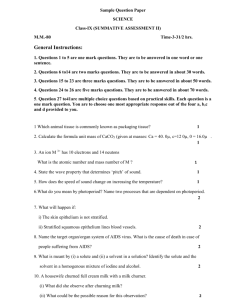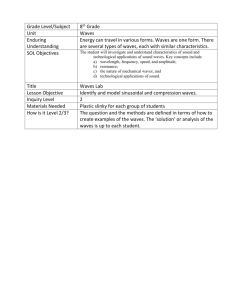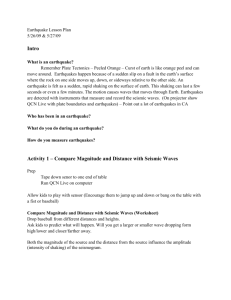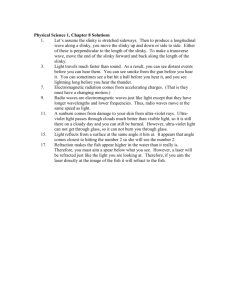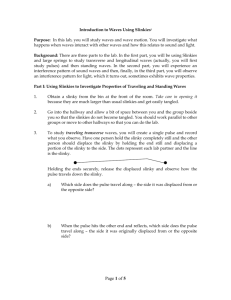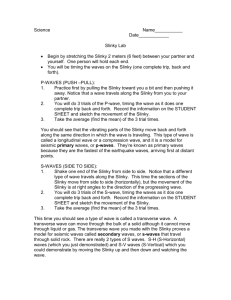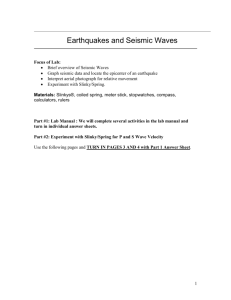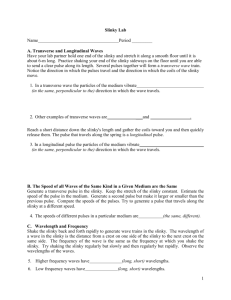The Hanging Slinky
advertisement
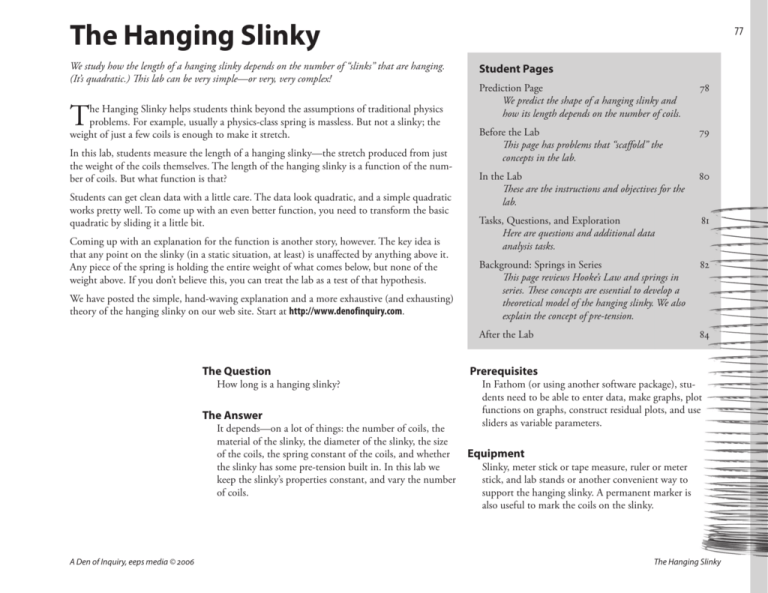
The Hanging Slinky We study how the length of a hanging slinky depends on the number of “slinks” that are hanging. (It’s quadratic.) This lab can be very simple—or very, very complex! T he Hanging Slinky helps students think beyond the assumptions of traditional physics problems. For example, usually a physics-class spring is massless. But not a slinky; the weight of just a few coils is enough to make it stretch. In this lab, students measure the length of a hanging slinky—the stretch produced from just the weight of the coils themselves. The length of the hanging slinky is a function of the number of coils. But what function is that? Students can get clean data with a little care. The data look quadratic, and a simple quadratic works pretty well. To come up with an even better function, you need to transform the basic quadratic by sliding it a little bit. Coming up with an explanation for the function is another story, however. The key idea is that any point on the slinky (in a static situation, at least) is unaffected by anything above it. Any piece of the spring is holding the entire weight of what comes below, but none of the weight above. If you don’t believe this, you can treat the lab as a test of that hypothesis. We have posted the simple, hand-waving explanation and a more exhaustive (and exhausting) theory of the hanging slinky on our web site. Start at http://www.denofinquiry.com. The Question How long is a hanging slinky? The Answer It depends—on a lot of things: the number of coils, the material of the slinky, the diameter of the slinky, the size of the coils, the spring constant of the coils, and whether the slinky has some pre-tension built in. In this lab we keep the slinky’s properties constant, and vary the number of coils. A Den of Inquiry, eeps media © 2006 77 Student Pages Prediction Page We predict the shape of a hanging slinky and how its length depends on the number of coils. 78 Before the Lab This page has problems that “scaffold” the concepts in the lab. 79 In the Lab These are the instructions and objectives for the lab. 80 Tasks, Questions, and Exploration Here are questions and additional data analysis tasks. 81 Background: Springs in Series This page reviews Hooke’s Law and springs in series. These concepts are essential to develop a theoretical model of the hanging slinky. We also explain the concept of pre-tension. 82 After the Lab 84 Prerequisites In Fathom (or using another software package), students need to be able to enter data, make graphs, plot functions on graphs, construct residual plots, and use sliders as variable parameters. Equipment Slinky, meter stick or tape measure, ruler or meter stick, and lab stands or another convenient way to support the hanging slinky. A permanent marker is also useful to mark the coils on the slinky. The Hanging Slinky 78 Prediction Page In this lab, you will be measuring how long a hanging slinky is. You will let various numbers of coils of the slinky hang straight down towards the ground and measure the stretched out length of the hanging coils. 3. Explain why you think the data will have the shape you predict: 1. Sketch the shape you think the hanging slinky will take: 2. How does the length of the slinky depend on the number of coils? Make your prediction below on the graph. If you can, estimate values to put on your axes: The Hanging Slinky A Den of Inquiry, eeps media © 2006 Before the Lab 79 1. If a massless spring stretches 1 cm when you hang a 100 g weight on it, what is its spring constant? 6. How much will a system stretch if it has two of the same springs and two 100 g weights set up as shown in the diagram? DN H H 2. Now imagine that you take two of the same type of springs from problem 1, and hang them in series, with 100 grams on the lower spring, as shown in the diagram. How far would the two springs stretch altogether? 7. If the two springs in the system shown in problem 6 were tension springs with 1 N of pre-tension and the same spring constant, how much would the system stretch? (Use g = 10 m/s2.) H (One Newton of pre-tension means that the springs don’t stretch at all for forces up to 1 N; beyond that they stretch like regular springs. For more discussion, see “Background: Springs in Series” on page 82.) H 3. What is the effective spring constant of the two springs in series? 4. How far would three of the same springs stretch if a 100 g weight was hung off the last one? What would be that system’s effective spring constant? 5. What is the effective spring constant of a system of n springs in series? A Den of Inquiry, eeps media © 2006 The Hanging Slinky 80 In the Lab How Do You Know When You’re Done? Data Analysis ❏ You have measured lengths up to at least 50 coils at 5-coil intervals. If you do your analysis in the lab, you can take additional measurements if you need them. ❏ You have a model that matches your data pretty well. ✧ In software, plot your data: length as a function of the number of coils. ❏ You understand and can explain any differences between your prediction and your model of your data. You have a residual plot that shows the difference between your model and your data. Setup ✧ Get your equipment: a slinky, and a meter stick or tape measure. ✧ Mark every fifth coil on the slinky with a permanent marker. ✧ Count how many coils the slinky has. Weigh the slinky, and measure its rest length. Record these measurements in your lab book or in your software. Data Collection ✧ Find a model (a function) that describes the data and plot it on the same graph. Your function should include a number of variable parameters. (In Fathom, use sliders.) ✧ Vary your parameters to find a good fit. ✧ If you can, make a residual plot to help you adjust parameters. Analysis Extensions ✧ Make sure your parameters have the right units. ✧ Relate your function and its parameters to a theoretical model of how the hanging slinky should work, and comment on whether the parameter values make sense. ✧ Make a data table—in your lab book or in software— to record data. Include columns for length and number of coils. ✧ Hang some of the coils of the slinky—either by hand or off another ruler or stand, as in the photo. ✧ Measure the length of the slinky for 5, 10, 15, 20, etc. coils until the slinky reaches all the way to the floor. Record the number of coils and the slinky length for each observation. ✧ Look closely and pay attention to the details of your measurement. Record unusual things that happen, adjustments you have to make, etc. The Hanging Slinky A Den of Inquiry, eeps media © 2006 Tasks, Questions, and Exploration 1. How did your sketch on the Prediction Page compare to the actual shape of the hanging slinky? 81 5. Use your function to predict how long a 47-coil hanging slinky will be. Test your prediction, if possible, and discuss any difference between your prediction and the test result: 2. Sketch your data and show your model on this graph: 6. If your slinky had 300 coils, how long would your function predict the entire hanging slinky to be? Do you think this is reasonable? Why or why not? 3. How does your data compare to your prediction? Describe any differences: 7. What do you think the parameters in your function are related to, and how? Explain your reasoning. (Hint: if the spring were stiffer, how would the data be different? How would that change your parameters?) 4. What function best describes the relationship between the length and the number of coils? A Den of Inquiry, eeps media © 2006 The Hanging Slinky 82 Background: Springs in Series Slinkies are very weak springs. How tight or weak a spring is depends on a lot of factors, such as the material of the spring, the coils’ thickness, the number of coils, etc. We often measure the strength of a spring by its spring constant (usually k). The bigger k is, the stronger the spring. Here is something you may not expect: holding everything else constant, the more coils a spring has, the smaller its spring constant. One way to test this odd claim is to look at springs in series. We’ll start with the diagram at left. If you put two identical springs in series, you are effectively doubling the number of coils the spring has. Hooke’s Law Before we go on to analyze the series springs, let’s review Hooke’s Law. Hooke’s Law says that the force F needed to stretch (or compress) a spring is proportional to the amount it is stretched, x. The constant of proportionality is called the spring constant, k. In equation form, Hooke’s Law is F = −kx . So if a spring has k = 5 N/cm, then 10 N will stretch the spring 2 cm. / / / / / / Now if you put the two identical springs in our example in series and apply a force of 10 N as shown in the diagram, they will stretch 4 cm, not 2 cm. Why? If you draw a free body diagram around each spring, each experiences the 10 N force. As in the example above, each will stretch 2 cm, and therefore the system of springs will stretch 4 cm. The system’s effective spring constant will therefore be (10 N ÷ 4 cm) or 2.5 N/cm, half that of a lone spring. Pre-tension Slinkies are also very weak tension springs. And they have some pre-tension. Pre-tension is the minimum amount of force before the spring has any stretch at all. The pre-tension in a slinky explains why the slinky collapses completely when it is not stretched. Once you are pulling harder than the pre-tension, a slinky will behave as Hooke’s Law predicts until you reach its elastic limit. So a modified Hooke’s Law for a slinky (or any tension spring that completely collapses) looks like this: F − Fp = −kx , where Fp is the amount of pre-tension. The pretension in slinkies is small, but it does produce noticeable effects. If you want to adjust Hooke’s Law to include L, the length, instead of x, the stretch, you can adjust Hooke’s Law using the substitution (L − L0) = x . So Hooke’s Law becomes: F − Fp = −k(L − L0) , where L0 is the rest length of the spring. This holds true as long as F > Fp; otherwise L = L0. In fact, if you have n identical massless springs in series, each with a spring constant of k, the effective spring constant of the whole assembly is k/n. The sum of the springs has a smaller spring constant than any of its parts! Similarly, if you take a spring with constant k and cut it up into n parts, each piece will have a spring constant of kn. It is a good exercise to show that this is true. The Hanging Slinky A Den of Inquiry, eeps media © 2006 Teacher Notes Pitfalls Students love to play with slinkies and can easily stretch them past their elastic limits. Permanently stretched slinkies mess up the data in this lab. How Far Do You Go? For many students, it may be enough to take the data and fit a quadratic of the form y = kx2 . Or they may look at the residuals, recognize that they need more parameters, and fit the data even better. To go only this far, don’t worry about the background pages, Hooke’s Law, or springs in series. But even if your students are not ready for the full theoretical treatment, you can still ask physics-oriented, more conceptual questions about the quadratic result. 83 Alternative Setup You don’t really have to hang the slinky with different numbers of coils. You can just hang it once and measure different numbers of coils, up from the bottom. You’ll get the same result. Somehow, though, we find that less satisfying. Sample Results Students get very clean data from this activity. It looks— and is—quadratic. You get pretty good results with a function of the form y = kx2 , but the residual plot will show you that things are a little off. This graph shows sample results using a standard metal slinky: Understanding the physics —why the model is quadratic, and why the parameter has the value it does, is harder. This is a case where we might develop a theoretical model after seeing the pattern in the data. It would be lovely if students came to the lab with a theoretical understanding to test and refine through experience, but that’s not going to happen every time. Even if we don’t develop a model yet, we know that whatever theory we eventually develop must predict this quadratic behavior. Theoretical Background Our solution to the hanging slinky problem appears on the web site, http://www.denofinquiry.com. Why put it there? So we can keep improving it. Briefly, each coil, starting at the bottom, supports one coil more than the one below. That means it’s stretched one more “unit.” The lengths of the individual coils increases linearly, so the sum of their lengths is quadratic. A Den of Inquiry, eeps media © 2006 These students produced two graphs: one with a plain quadratic, and one (on the right) where they have shifted the vertex to the right by an amount dC. The residual plots have the same scale, with length in centimeters. You can see that the extra parameter substantially improved the fit, as measured by the size of the residuals. The Hanging Slinky 84 After the Lab Consider any of these discussion topics or whole-class tasks: What measurement challenges did you face? Why do the coils at the top stretch more than the coils at the bottom? Coils experience different loads. How does the load change throughout the slinky? What might explain any systematic error in your residual plots? Verify that the coefficient in front of the equation is mg close to 2k where: k is the spring constant of one coil, m is the mass of the slinky, and g is the acceleration due to gravity. Why does it make sense that the variables are where they are in the equation (e.g., m in the numerator)? What might explain the 1/2 factor? Did you represent the rest length of the slinky’s coils in your equations? If so, how? Does it matter that the slinky has a small amount of pre-tension? (See “Background: Springs in Series” on page 82.) What does “the spring constant” mean if we’re looking at different numbers of coils? The Hanging Slinky A Den of Inquiry, eeps media © 2006


